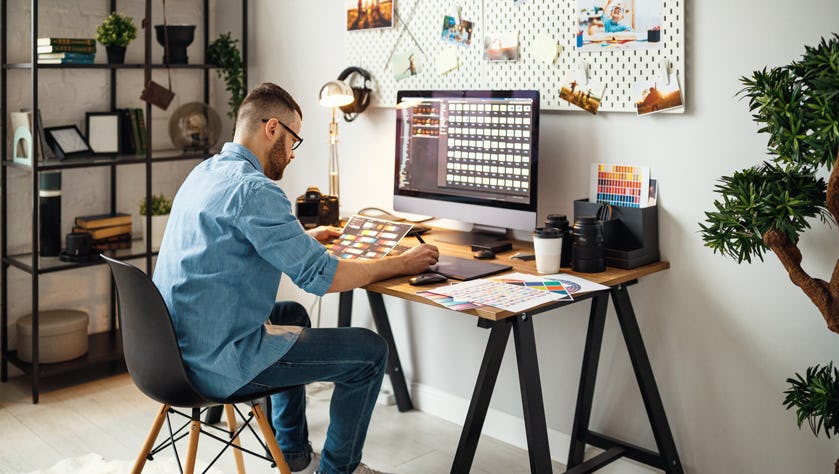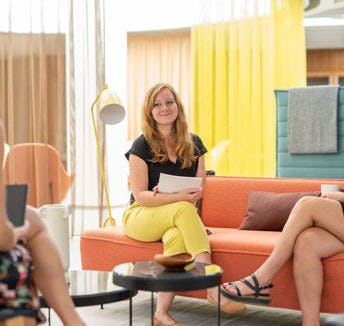
Workplace creativity is like a muscle: it needs regular exercise if we want it to stay strong. Check out these tips for keeping your creativity alive, wherever you’re working
A 2020 survey by LinkedIn revealed that creativity is one of the most in-demand soft skills in the workplace. Viewed as critical for problem-solving and innovation, creativity is something employers look for no matter what position they’re trying to fill.
Whether you’re a software engineer, a marketing copywriter or a project manager, being more creative means being better at your job – but it can be tough to stay inspired and inventive when you’re busy.
What’s more, many of us feel burnt out after months of remote working, forced on employees and employers alike by the Covid-19 pandemic. While being based at home has its benefits, it comes with challenges, too: domestic distractions can make it difficult to focus when the line between home and the office becomes blurred, let alone think outside the box.
As countries around the world begin to lift restrictions and a new, hybrid approach to working takes hold, it’s likely many of us will begin splitting our time between the company HQ, home and a third location, such as a nearby flexible workspace.
Here, we look at ways to boost your creativity wherever you are.
Working from home
It can be hard to conjure up new ideas when you work from home. Surrounded by jobs that need to be done and bothered by family members or insistent pets, you may find headspace for ingenuity is in short supply.
James Clear, author of Atomic Habits, suggests designating a specific place for creativity. He explains that identifying a place for thinking creatively is a way to ‘wall-in’ your work, rather than letting it spill out everywhere at home.
If you can’t move to a different room when you need to spend time thinking creatively, you could try introducing ‘micro-adjustments’ to your workspace. One such adjustment might be sitting in the same place every time you answer work emails, or moving your chair into a different space and designating that area as the creative zone when the time is right.
One of the main issues those working from home experience is the inability to switch off at the end of the day. “At the end of my work day, I take 10 minutes and kind of put everything away that I can,” says happiness expert and author of Outer Order, Inner Calm, Gretchen Rubin.
Tidying your desk, writing a to-do list for tomorrow or taking a walk outside can all form part of a ‘close-down ritual’ that helps to clear the mind, leaving it open to a new burst of creative thinking (which may or may not be work-related!).
Working from HQ
If companies encourage and support creative thinking in the office, creativity can become a core part of company culture. As firms adopt hybrid working for the long-term and corporate HQs become spaces for collaboration, rather than day-to-day work bases, fostering a culture of innovation is arguably more important than ever.
Creativity is affected by our environment, so switch it up a little by kitting out your workspace with plants, good lighting and photos. As an employee, you can do this at your own desk – but if you’re an employer, you can go to town throughout the office.
It can also be helpful to move around during the working day, according to Robert Epstein, Senior Research Psychologist at the American Institute for Behavioral Research and Technology. “You want your physical and social surroundings to change,” he says. This is in order to refresh and reset your mind: staying in one spot means thinking can become staid and uninspired.
On a similar note, the sedentary nature of office work tends to tamp down creativity, with the average employee sitting for between seven and 15 hours per day. “A physical workout clears the mind and opens up the space for creativity to enter,” says Ben Crudo, e-commerce expert and CEO of Diff Agency.
Incorporating regular exercise into your working day, whether it’s a run at lunchtime or a wander around the local park, can release mental blocks and spur creative inspiration. This might seem easier to do when working from home than on days when you’re based at HQ, but it’s worth making the extra effort – especially as a stroll or jog can also provide the opportunity to catch up with colleagues.
Working from a flexible workspace
Experts agree that collaborating and learning from others can really help with creative thinking. “Innovation is not [some] random unpredictable act of genius,” says Andrew Ng, cofounder of Google Brain. “Instead, one can be very systematic in creating things that have never been created before.”
Choosing to work in a vibrant coworking space means you’re likely to be surrounded by other, like-minded professionals: people you can network with, learn from, bounce ideas off and be inspired by.
“Creativity is a team sport,” agrees David Burkus, author of Friend of a Friend and The Myths of Creativity. Meeting new and interesting people is like fuel for your creative fire.
Spaces locations regularly host networking events that are designed to help you make valuable social and professional connections. Talks from local business leaders, networking lunches and even fitness sessions might be on the agenda at a Spaces near you – and all could help to give your creative muscle a welcome workout.
Enjoy this? You might also like these Spaces magazine stories:
How to create effective work-life boundaries
Seven smart ways to boost your wellbeing when you return to the office
Share this article
 Read now Six ways to boost creativity when working in an office
Read now Six ways to boost creativity when working in an office
 Read now Hybrid working or a 10% pay rise: what would you choose?
Read now Hybrid working or a 10% pay rise: what would you choose?